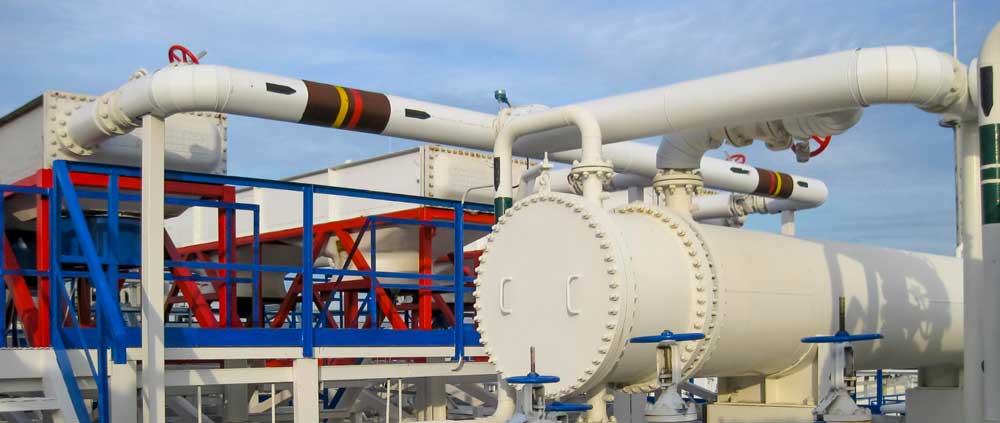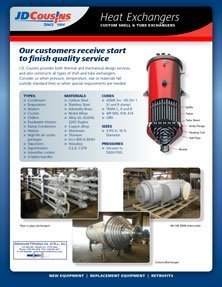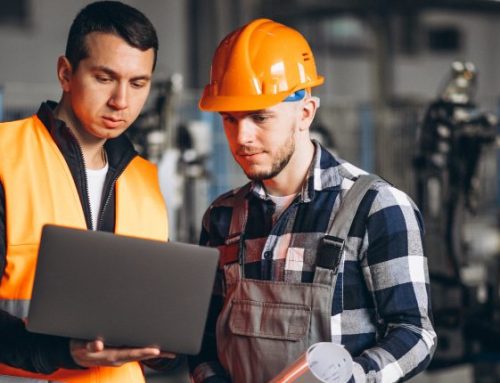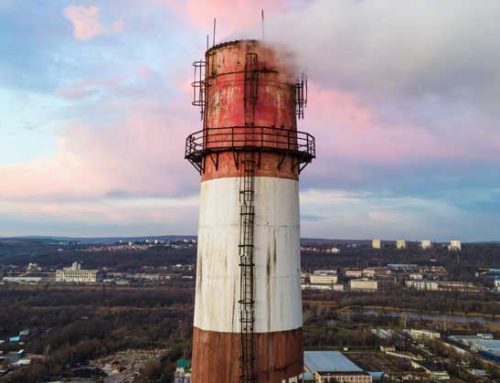Here at Advanced Filtration, we work with a diverse array of industrial filter product, from mist eliminators to Y-strainers to HVAC media filters, and everything in between. You’ll find all kinds of literature in our blog about all of these lines we carry, and today we’re going to discuss a specific topic: heat exchangers.
What Is a Heat Exchanger?
A heat exchanger is a device designed to efficiently transfer heat from one medium to another without coming into direct contact. It’s used in various applications where the heat from one fluid (liquid or gas) needs to be transferred to another fluid without mixing them. Many of Advanced Filtration’s clients require exact-specified materials for their heat exchanger needs.
Heat exchangers are found in everyday appliances, including air conditioners, refrigerators, and car engines. But they are also used in industrial processes such as power generation, chemical processing, and HVAC systems. They come in different types, such as shell and tube, plate, and finned tube exchangers, each suited for specific purposes depending on a variety of factors, including:
- The required heat transfer efficiency;
- Space available for the product;
- The nature of the fluids involved.
How Heat Exchangers Work
As mentioned above, a heat exchanger works by transferring heat from one fluid to another fluid without allowing them to mix. There are various types of heat exchangers, but the fundamental principle remains consistent across them. Here’s a simplified explanation of how a basic heat exchanger operates:
- Two Fluids: There are two separate fluid streams: one fluid that needs to release heat (the “hot” fluid) and another fluid that needs to absorb that heat (the “cold” fluid).
- Separation: These fluids flow through separate channels or compartments within the heat exchanger, ensuring that they do not mix together.
- Heat Transfer: The hot fluid passes through the exchanger, and as it moves, its heat transfers through the walls of the exchanger to the cooler fluid without the fluids themselves coming into direct contact.
- Temperature Equalization: The heat transfer causes the temperature of the hot fluid to decrease while increasing the temperature of the cold fluid until an equilibrium is reached or until the desired heat exchange has occurred.
- Flow Continuation: The now-cooled hot fluid and the heated cold fluid continue on their separate paths, carrying out their respective functions in the system.
The design and efficiency of a heat exchanger depend on various factors, such as the type of exchanger used, the materials from which it was manufactured, the flow rates of the fluids, the temperature differences between the fluids, and the overall intended purpose of the heat exchange.
Different types of heat exchangers utilize specific methods (like tubes, plates, or fins) to maximize surface area contact between the fluids, enhancing heat transfer efficiency. This allows for efficient exchange while maintaining the separation of the two fluids.
Heat Exchangers In Power Generation
Heat exchangers play vital roles in various forms of power generation, including in thermal power plants, nuclear power plants, and even in renewable energy systems like geothermal power. Their primary function in power generation is to manage and transfer heat to optimize energy production.
Advanced Filtration fields a lot of calls from power generation professionals, so if you have a question about power plant filters, give us a call today at 732-901-6676 or use the contact form on this page.
Here’s how heat exchangers are used in different types of power generation:
- Thermal Power Plants (Fossil Fuels): In thermal power plants using fossil fuels (such as coal, natural gas, or oil), the basic principle involves burning fuel to produce heat. This heat is used to convert water into steam, which drives a turbine connected to a generator to produce electricity. Heat exchangers are crucial in these plants. Heat exchangers called boilers are used to convert water into steam by transferring heat from burning fuel to the water. And after the steam passes through the turbine, it’s condensed back into water by transferring its heat to a separate cooling medium (often water from a nearby river, lake, or a cooling tower). This heat transfer occurs in condensers, allowing the steam to be reused in the boiler, thus improving efficiency.
- Nuclear Power Plants: In nuclear power plants, heat exchangers are crucial for managing heat generated by nuclear reactions. Similar to thermal plants, the heat produced is used to generate steam, which drives turbines to produce electricity. The primary heat exchanger here is called a steam generator, which transfers heat from the nuclear reactor to the water to produce steam.
- Geothermal Power Plants: Geothermal power harnesses heat from the Earth’s core. Heat exchangers are used to transfer the thermal energy from hot underground water or steam to a secondary fluid (such as a working fluid like isobutane) that drives a turbine to generate electricity.
In all these cases, heat exchangers are pivotal in maintaining the efficiency and safety of power generation systems by managing and transferring heat between different mediums without allowing them to mix. They help in optimizing energy conversion, improving efficiency, and ensuring that the equipment operates within safe temperature limits.
The Importance Of Heat Exchangers
When it comes to power generation and industrial filtration in general, heat exchangers are incredibly important for many reasons:
- Efficiency: They enable efficient transfer of heat between two fluids without allowing them to mix. This process allows systems to harness and utilize heat more effectively, whether it’s for heating, cooling, or energy generation purposes.
- Energy Conservation: By facilitating heat transfer, heat exchangers contribute to conserving energy. They allow systems to recover and reuse heat that would otherwise be wasted, making processes more energy-efficient.
- Temperature Control: As the name suggests, heat exchangers help regulate temperatures within systems, ensuring that equipment operates within optimal temperature ranges. This prevents overheating or excessive cooling, which can damage machinery or reduce efficiency (see the first bullet).
- Environmental Impact: In many industries, heat exchangers help reduce the environmental impact by improving energy efficiency. For example, in power plants, better heat exchange means less fuel consumption and fewer greenhouse gas emissions.
Read more about how industrial filtration reduces air pollution.
Heat exchangers have a wide range of diverse applications across industries, including heating and cooling systems in buildings, refrigeration, air conditioning, chemical processing, power generation, automotive engines, and more. Their versatility makes them integral to numerous technologies.
They enable better control and optimization of industrial processes by efficiently managing temperature variations and facilitating heat recovery, leading to improved production rates and product quality. Overall, heat exchangers are crucial components in numerous systems and processes, contributing significantly to energy efficiency, environmental sustainability, and the effective operation of various technologies and industries.
Cost and Maintenance of Heat Exchangers
The cost of heat exchangers can vary significantly based on several factors, and you might find that a free consultation with Advanced Filtration can help you price out the right solution for your needs. Nevertheless, the following are some considerations when pricing out heat exchangers, and what is required for maintaining one.
- Type and Design: Different types of heat exchangers (such as shell and tube, plate, finned tube, etc.) have varying complexities in their design and construction, which can affect their cost. Some designs might be more intricate and require specialized materials or manufacturing processes, thus increasing their price.
- Materials: The materials used in constructing heat exchangers greatly influence their cost. Exotic metals or alloys that offer specific properties like corrosion resistance, thermal conductivity, or durability can significantly raise the price compared to more common materials.
- Size and Capacity: The size and capacity of a heat exchanger are crucial cost determinants. Larger heat exchangers designed for higher flow rates or greater heat transfer capacities tend to be more expensive due to the increased material and manufacturing requirements.
- Customization: Custom-designed heat exchangers tailored to specific applications might be more expensive compared to off-the-shelf models due to engineering and design costs associated with customization. Interested in customization? Call us for a free quote.
- Quality and Standards: Heat exchangers built to higher quality standards, with better efficiency and longevity, might come at a higher initial cost but could potentially save money in the long run through improved efficiency and reduced maintenance. Here at Advanced Filtration, we only represent the highest quality brands and products.
In general, while heat exchangers can represent a significant investment, their cost-effectiveness often lies in their efficiency, longevity, and ability to save energy in the long term. The overall expense of a heat exchanger depends on the specific requirements of the application, the materials used, and the technology employed in its construction.
In addition, maintaining a heat exchanger is crucial for it efficient and long-term operation. Here are some common maintenance practices:
- Regular Inspections: Scheduled inspections allow for the early detection of potential issues. Inspect for leaks, corrosion, fouling, or any signs of wear and tear.
- Cleaning: Fouling, scaling, or deposits can reduce heat transfer efficiency. Regular cleaning helps remove these deposits. Methods include chemical cleaning, mechanical cleaning with brushes or scrapers, or using high-pressure water or steam.
- Fluid Analysis: Analyzing the fluids circulating through the heat exchanger can provide insights into potential issues like corrosion, contamination, or degradation. Monitoring fluid quality helps in identifying problems early.
- Tube Inspection: For tube-based heat exchangers, inspecting the tubes for cracks, erosion, or other damage is vital. Techniques like non-destructive testing (such as ultrasonic testing) can be used for inspection without causing damage to the tubes.
- Seal Checks: Ensure gaskets, seals, and connections are intact and in good condition. Leaks can significantly reduce efficiency.
- Corrosion Protection: Implementing corrosion prevention methods, such as using corrosion-resistant materials or coatings, can prolong the lifespan of the heat exchanger.
- Operating Parameters: Regularly monitor and adjust operating parameters such as flow rates, temperatures, and pressures to ensure the heat exchanger operates within optimal conditions.
- Repairs and Replacement: Address any identified issues promptly. Replace damaged components, repair leaks, or consider overhauling the heat exchanger if necessary to maintain its efficiency.
- Documentation and Records: Maintain comprehensive records of maintenance activities, inspections, and any repairs made. This documentation helps in tracking the heat exchanger’s performance and aids in planning future maintenance. It will also help, if you have it handy, in any conversation you have with Advanced Filtration–as we determine the right product for your specific needs.
Regular and proactive maintenance not only ensures the efficient operation of heat exchangers but also extends their service life, reduces downtime, and minimizes the risk of costly failures.
Reach Out To Advanced Filtration For Help With Heat Exchangers
As you can see, a heat exchanger is a large investment and requires a ton of forethought and expertise. Call Advanced Filtration today to discuss the right heat exchanger solution for your needs, or use the contact form on this page. We look forward to helping you!








